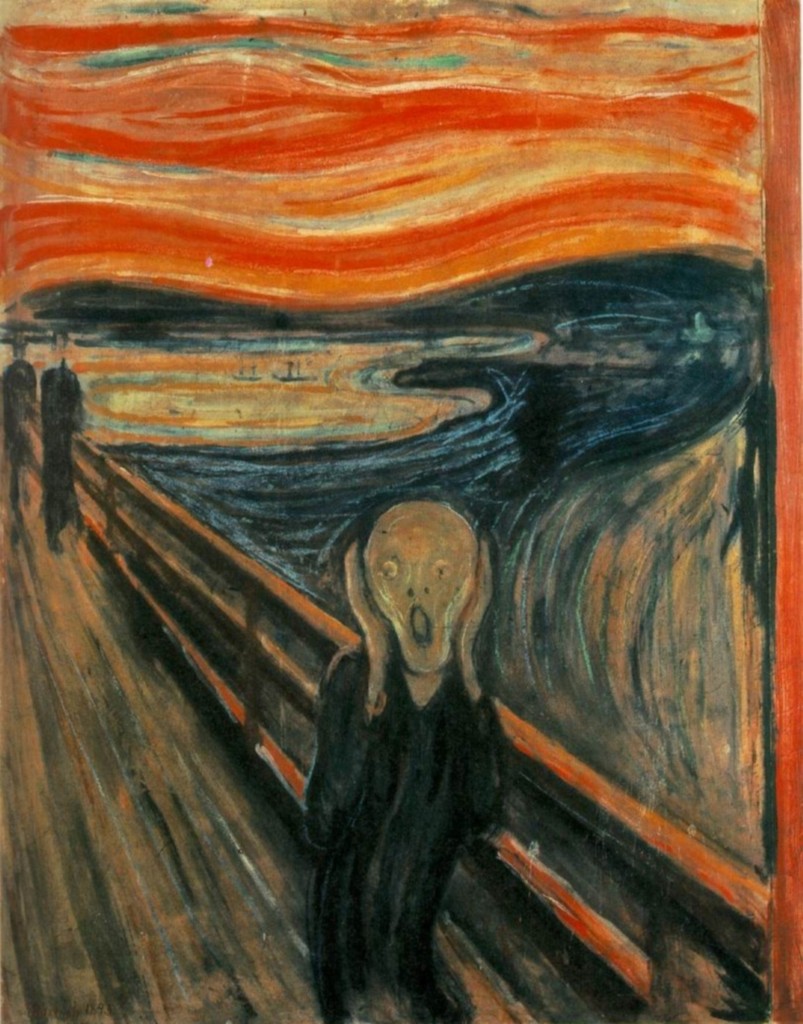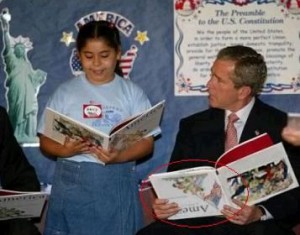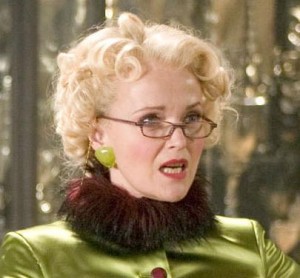I’ve just come back from Sheffield, where the 2016 Centre for the Study of Childhood and Youth conference was taking place from Tuesday to Thursday. It was a Childhood Studies conference, focusing on the ‘social, biological and material dimensions of childhood and children’s everyday lives’.
This was my first Childhood Studies conference – I generally go to Children’s Literature conferences, but in the past three and a half years, save for a couple of articles, my research has reoriented itself towards neighbouring fields, such as the cultural sociology of childhood and of education, and the history of childhood. While I’m not an empirical researcher, I’m tending towards questions and topics close to Childhood Studies, and I read their journals; so I thought it was high time I went to one of their conferences.
This isn’t going to be a detailed report, but rather some thoughts on the interesting differences between Children’s Literature and Childhood Studies, as far as I can tell from my admittedly limited experience of the latter. Mostly, it was fascinating to see how different those two neighbouring fields are.
This can be visualised in a very scholarly way by looking at the completely different Conference Bingos. Here’s my Children’s Literature conference bingo:
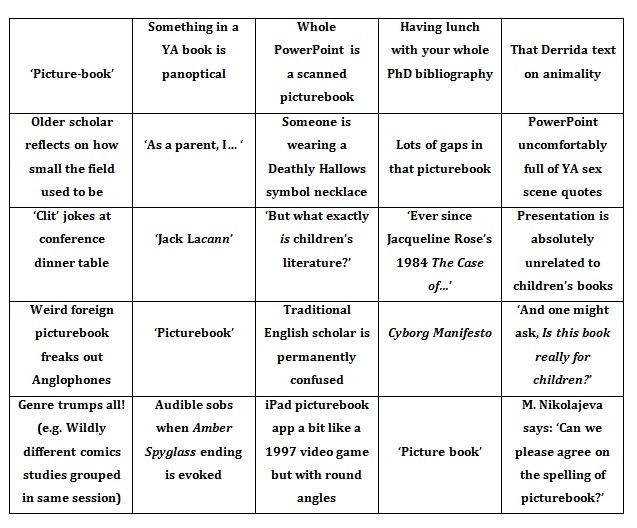
At the Childhood Studies conference, however, I had no Conference Bingo in mind. I had to make it up as I went along, noting resonances, repetitions, funny little tics of language and turns of phrase that were new to me but extremely familiar to CSCY veterans. And there was interestingly very little overlap with current concerns in Children’s Literature studies. Here’s what struck me in particular.
- Concerns with method
There was a lot of thinking about method going on, almost as a matter of course, both within presentations and in the Q&As. This is probably in part because so much of Childhood Studies is empirical, and so much of that empirical work ethnographic; method and methodologies, ethical considerations and the place of the researcher were constantly probed. This may seem simply like good practice, but it was clear that presenters weren’t just going through the motions; their reflections on method were indissociable from their conceptualisations and theoretical commitments, and practice, theory and method mingled fluidly, in a way that I haven’t really seen happening in Children’s Literature. Method, to put it simply, wasn’t a tool; it was always already thought.
This isn’t to pit Childhood Studies against Children’s Literature – it’s just an observation. If we need a ‘conversely,’ then I observed that at CSCY there was little to no engagement with the aesthetic aspects of the cultural objects studied. When children’s TV, books, films, etc. were observed, literary criticism, aesthetic visual analysis, film criticism, etc. were (at least in the talks I saw) not at all mobilised.
- Latourian frameworks, and ‘assemblages’
Granted, this was a conference focusing on the material and biological child, so, as one of the professors there rightly pointed out to me, it had Latour written all over it; and the Frenchman has been a reference for some major Childhood Studies thinkers for quite some time. But there are other theorisations of materiality; so it was interesting to see how much Latour and Actor-Network Theory specifically resonated in the field. It’s easy to see why; ‘the child’ is a textbook example of a Latourian (quasi)object, involved at the same time with many different types of other actants, objects, knowledges, etc. and irreducible to any in particular. Entanglement was one of the recurring keywords.
Another keyword was ‘assemblage’, pulled from a rather different tradition but used almost interchangeably, as far as I could tell, with ‘entanglement’, ‘networks’ or similar expressions.
- Some unease with both traditional and emergent social categorisations
I didn’t see a lot of criticism of Latour, but in a brilliant presentation on children’s engagement with TV, Fiona Scott of Sheffield University highlighted the necessity to buttonhole Bourdieu once in a while, too, so as not to risk leaving class aside. That’s the problem with Latourian or equivalent approaches: fearing reductionism, it’s hard not to spend all your time describing relations, and shying away from explanations – especially from social causes.
I had a feeling that presenters were tiptoeing around explanations involving traditional social categories; they didn’t mention class, gender nor race as much as I would have thought. It was nothing like Children’s Literature, where such categories are hugely mobilised in analyses of texts. Similarly, I didn’t hear much about emergent categories. There was a little bit of disability studies. Strikingly, I heard the word ‘intersectionality’ uttered only once (obviously, I didn’t go to all the talks – I don’t have a Time-Turner); a major difference here from Children’s Literature.
Yet at the same time, almost inevitably the Q&As triggered reflection on gender, race, class, etc. I’m not sure if it’s because the conference theme kept those categories at bay, only for them to be reintroduced after the talks; or if it reflects some wider discomfort, or incompatibilities, within the apparently current ‘turn’ of Childhood Studies towards materiality.
- No consensus on ‘agency’ and ‘voice’
Relatedly, the concepts of ‘agency’ and ‘voice’ of the child were in a paradoxical position. Routinely there were calls to transcend them or move beyond them; at the same time, I observed that those concepts were much-used in presentations by researchers who were also educators or teachers. In other words, there seemed to me to be an interesting discrepancy between the apparent theoretical obsolescence of these concepts, and their continued usefulness in pedagogical practice.
From a Children’s Literature perspective, that discussion maps nicely onto the question of child and adult ‘powers’ within and around the children’s text, which is of course one of my obsessive concerns. That’s where I saw, perhaps, the most resonances between the two fields.
- Reflections on the constructedness of childhood are still important
I was expecting to find that ‘constructions of childhood’ was now a taboo expression in Childhood Studies, but I was happy to see that it was not the case, with the appropriate caveats in place. I think it was clear and uncontroversial that childhood remains a social construct – and one that is structuring for ‘people currently occupying the space socially defined as childhood’, in the words of Nigel Thomas in his keynote on the matter. Those meandering ways of saying ‘children’ are awkward, of course, but they show that the (important) work on reclaiming (as per above) the child’s ‘voice’ and ‘agency’, and the current work on the interconnectedness of children with everything, still allow for space to reflect on what effectively does construct childhood.
- A lot of political and ethical commitment
Like Children’s Literature, I found Childhood Studies to be an intensely moral and political arena (in the good sense of the word). There was a lot of preoccupation for the future not just of the discipline but, quite literally, of humanity – a remarkable amount of comments and reflections on climate change, for instance – and of the role of children and researchers in this space. All the keynote speakers exhorted other researchers to be politically and ethically committed; they didn’t necessarily phrase it in that way, but it was very clear.
Perhaps the most inspiring bit of the conference for me was Spyros Spyrou‘s keynote, in which he highlighted the power of method to ‘create alternate realities’ – by which he meant, not alternate representations, but truly alternate realities; an effecting shaping of the world. Faced with that, we must resist relativism; we have an obligation to make ethical choices as to which realities we want to come into being.
————
So what’s my Conference Bingo for Childhood Studies? It can’t be complete nor representative, of course, from a sample of just one, but here’s a try, from my semi-outsider perspective:
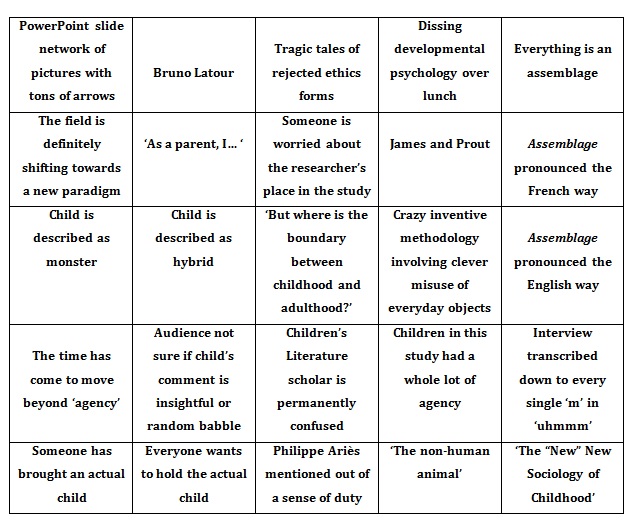
(You will note that ‘As a parent’ is present in both.) With that in mind, I look forward to next year’s IRSCL conference at York University, Toronto (not to be confused with the far nicer superlatively better University of York, UK), whose theme is, appropriately, ‘Children’s Literature and Childhood Studies’.

